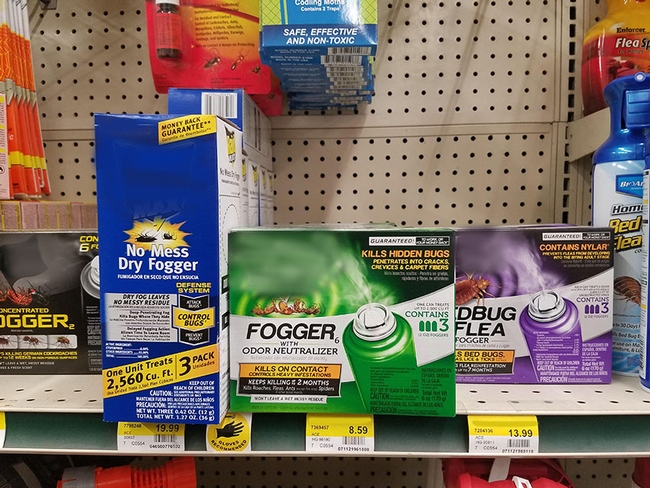Insecticide foggers, also known as total release foggers or “bug bombs” (Figure 1), are popular products widely available in many retail nurseries and garden centers as well as drug stores, supermarkets, and convenience stores. These easy-to-use products may seem to provide an easy way to kill a lot of bugs fast and may be viewed as more convenient and cheaper than hiring a pest management professional. But do they work?
Are Foggers Effective?
Foggers can be used effectively to kill pests that are flying around or resting on surfaces, like flies, but there are better long-term and more effective ways to manage these pests. Unfortunately, foggers are rarely effective for control of crawling insects like cockroaches, fleas, and bed bugs that can easily hide in crevices or beneath household items, escaping direct exposure. For best results, the active ingredients in these products must make contact with the pests. Insects that spend most of their time hiding will not be significantly affected by insect foggers. Even a small piece of fabric may be enough to protect bed bugs from the pesticide fog created by these products.
Since foggers leave a toxic residue on treated surfaces, users might see a few dead roaches after application, but many active ingredients in foggers are known to be repellent and may even drive pests deeper into wall voids and other hard-to-reach locations, sometimes even spreading them to other rooms. Pesticide resistance is another reason that insect foggers may not work. Many insect foggers contain pyrethrin or pyrethroid insecticides and some populations of household pests are known to be resistant to these pesticides.
Improper Use Can Cause Injuries

Foggers can also make people sick if they're exposed. In studies by the CDC, the most commonly reported symptoms after exposure were cough, upper respiratory pain or irritation, difficulty breathing, vomiting, nausea, and abdominal pain or cramping. Most of the time, the symptoms were mild and didn't require medical treatment, but there are reports of more serious injuries and people have even died from injuries related to foggers. According to these studies, injuries frequently happen when users don't read the instructions on the label. People can be also be exposed to the insecticide if they don't leave the premises after releasing the trigger on the product or return to their homes too early.
The labels of these products also instruct users to clean all exposed surfaces after use since these products leave pesticide residues. Failure to follow these instructions can lead to health hazards. The pesticide residues can be irritating, especially to occupants with asthma or other respiratory ailments.
For Safety, Follow the Label!
If you decide to purchase foggers, it is important to read and strictly following the instructions on the product label. You need to know the size of the room you're treating before going to the store, so you know how many foggers to buy. Otherwise, be sure to measure the size of the area you are treating before you begin fogging. More pesticide is not better; more can be dangerous.
For more information and safety precautions, see the US EPA website.
The National Pesticide Information Center also lists considerations and limitations when using foggers, along with several other resources for more useful information.
There are many effective ways to manage insect pests in the home. You can learn more on the UC IPM website. There you'll find practical, effective methods for controlling common household pests, without exposing yourself or other occupants of your home to pesticides.
[Original article published in the Winter 2020 issue of the Retail Newsletter.]
Author - Coordinator, Pesticide Safety Education Program and Office of Pesticide Information and Coordination (OPIC)
